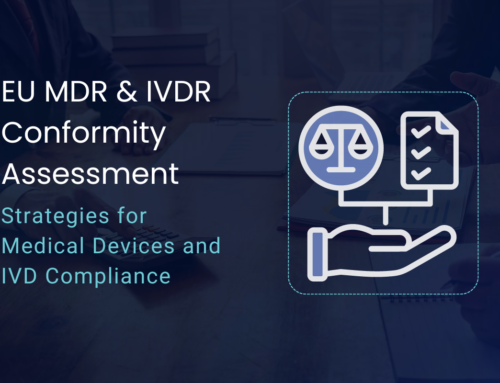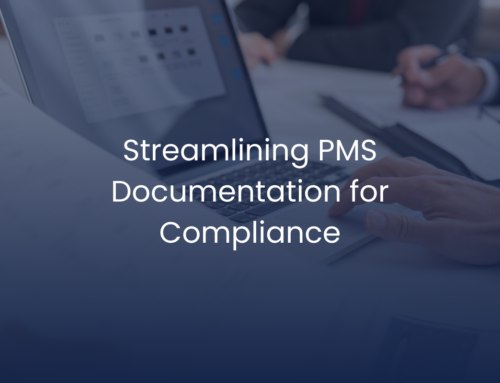
Clinical Evaluations for Unique Product Types Under the EU MDR – Webinar
Dr. Matthias Fink is board-certified orthopaedic and trauma surgeon with over 17 years of experience in orthopaedic, trauma, and reconstructive surgery, with extensive training in cardiovascular and thoracic surgery. He is the Global Team Leader for the Ortho, Trauma, and Dentistry Team within the Clinical Centre of Excellence for TÜV SÜD, and the Team Manager of the Clinical Focus Team in North America.
Manufacturers of medical devices must carry out a clinical evaluation of their products in order to be allowed to market them in Europe. To do this, the manufacturer must use clinical data to confirm that the medical device is safe and functions as intended. The manufacturer then assesses whether the risks of use are in a reasonable proportion to the expected benefits. During our webinar titled “Clinical Evaluations for Unique Product Types Under the EU MDR”, Dr. Matthias Fink spoke specifically about the MDCG guidance documents, equivalence demonstration, and different articles of the MDR for clinical evaluation plans.
Why should you read the transcript / watch this video?
- To understand the strategies and approaches to consider for specific product types
- To get an overview of the updates on regulations and guidance documents
A full transcript of Dr. Mattias Fink’s presentation is available to download (and to read below) and just press play to watch the clip now.

Claim Your Free EU MDR Checklist Now!
Make sure you and your business are compliant with the new EU MDR. Get our 23 page checklist for actionable technical documentation requirements.
Introduction
Good Morning. I would like to step back a little, to give a more high-level overview. We already have a lot of MDCG documents published, and there will be more guidelines coming. There’s still discussions on the interpretation of certain paragraphs of the MDR. So, what I am going to talk about today is our current interpretation.
MDR Guidance Documents
I just mentioned them, but I want to highlight the MDCG guidance documents. A lot of them are already published, and a couple more are still to come. We are still waiting for the PSUR guidance and templates for the post-market setting. This is the guidance document everyone is very anxiously waiting for. We have a couple of guidance documents already published, which are related to clinical evaluation and specially, to the unique clinical devices. One is, MDCG 2019 – 11, on the classification of software as Medical device, as well as 2020 – 1 on clinical evaluation of medical device software. For software, it is a big change because it was not really considered in the previous directives. So, this is a big step forward for software manufacturers and for manufacturers who have software as an integral part of the medical device.
I always recommend reading those guidance documents. They are not legally binding as they are guidance documents, so they are not regulation & not the law. But in Europe, the authorities of different member states require notified bodies to follow these guidance documents. The notified bodies are going to challenge you on the requirements as set out in those guidance documents. I really encourage everyone to be familiar with the guidance documents because you might receive some challenges on those aspects from your Notified body.
Two guidance documents everyone really was waiting for are MDCG 2020 – 5 and – 6 on equivalence approaches, and on sufficient clinical data for legacy devices. I am going to touch on this little bit later on. There is a MDCG guidance on transitional provisions for consultations (DDC). I am also going to quickly talk about consultations for drug device combinations and what is required from a clinical perspective for combinations. And the last one on this list, is MDCG 2020-13 on the Clinical Evaluation Assessment Report Template, which basically is the unique template that every notified body is expected to follow. That template is what every notified body has to use for our assessments of clinical evaluation reports that we are going to receive from the manufacturers of certain devices. I am only mentioning ‘consultation’ according to article 54 regarding the mandatory legal consultations with the expert panel. Some of those CEAR reports will be publicly available – at least for the expert panels and for the common authorities.
This is why we have to align with the template every notified body is expected to use, and this template is publicly available. So, the notified body will probably implement them into their own documents. I encourage everyone to please make a note of that template because whenever you ask the question, why is my notified body asking me this in relation to a clinical evaluation? This is probably coming from that template because this is the information that the notified body needs to assess during the review.
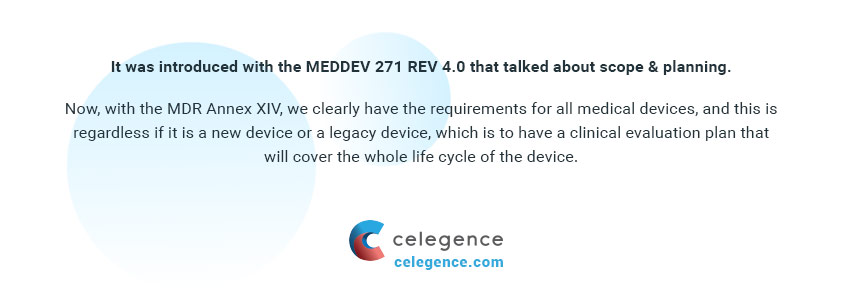
Annex XIV, Part A: Clinical Evaluation Plan
So, going into that further – it was introduced with the MEDDEV 271 REV 4.0 that talked about scope & planning. Now, with the MDR Annex XIV, we clearly have the requirements for all medical devices, and this is regardless if it is a new device or a legacy device, which is to have a clinical evaluation plan that will cover the whole life cycle of the device. A couple of things that are highlighted here, are also newly-introduced with the MDR. With the MDD – of course, you are required to have your labeling define the indication and contraindication, but there was no real requirement of a predetermined target group. So now, the manufacturer is required to define this target population, and then of course, to ensure the life cycle of that device has sufficient data for the whole target population.
Another interesting and new aspect is the clinical benefit to patients, with relevant and specified clinical outcome parameters. MDR article 2 defines clinical benefits as the positive effects that the device has on the patient. It’s not necessarily the intended use, for example, if you have the intended use being a hip prosthesis, you will probably say it’s intended use was replacing the hip joint. This is not necessarily the benefit for the patient. In this case it would likely be restoring mobility or reducing pain.
There are a lot of different things that need to be considered, and that the manufacturer has to define in the clinical evaluation plan. They must also provide the specific outcome parameters like the radiological scores if it is a bone implant, or if any kind of patient scores are needed to confirm the benefits to patients. The last topic is the clinical development plan – the MDR clearly requires the clinical development plan to be part of the clinical evaluation plan. The clinical development plan is much more relevant for the review by the notified body for a new medical device, but it also has to be addressed in the clinical evaluation plan for a legacy device. For legacy devices, it probably could be the summary of the clinical evaluation plan – which steps the manufacturer took, or what actions they took before obtaining the CE mark.

Claim Your Free EU MDR Checklist Now!
Make sure you and your business are compliant with the new EU MDR. Get our 23 page checklist for actionable technical documentation requirements.
MDR Article 61
For Class 3 devices and implantable devices as a general rule – clinical investigations will be expected. That is roughly the same as the MDD. But of course, we all know there were a lot of possible exceptions where a manufacturer obtains a CE Mark without having a pre-market clinical investigation. One big factor, which a lot of notified bodies have seen in the past with the MDD, was the equivalence approach. This is still possible with the MDR, but it has become much more stringent. Everything I am talking about right now also applies to any kind of drug device combinations. If the drug device combination product in the past relied on clinical data from the equivalent device, then the same is going to apply here as well.
Legacy devices are any device that is already marketed under the directives of either MDD or AIMDD. Then we have article 61.6b – which is a list of exempted devices that are not required to have clinical data, including dental implants, sutures, plates, and screws. If they have sufficient data, and it can be demonstrated, then a premarket investigation is not required.
Equivalence Demonstration
Talking about equivalence, MDCG 2020-5 provides us with more clarification on the definition of equivalence. Those of you who are familiar with the MEDDEV REV 4.0 – these characteristics are similar to the extent that there would be no clinically significant difference in the clinical performance and safety of the device. The differences between your device and the proposed equivalent device though, can only be to the extent that it will not have any clinically significant difference. But what does clinically significant mean? It depends on the device. Of course equivalence has to be based on proper scientific justification, and has to be based on preclinical data. Just a descriptive demonstration of equivalence that is pictures of the two devices next to each other, and comparing the wording, is not sufficient.
The most important topic that the manufacturer has to demonstrate are the sufficient levels of access to the data for devices to which the manufacturer is claiming equivalence. This has to be done by a contract between manufacturer A and manufacturer B in this case.
MDCG 2020 – 5 Equivalence
This contract is required for all implantable, and all class 3 devices. If it is coming from the same manufacturer, then they should have sufficient access to their own technical documentation. They must be able to demonstrate this in a detailed way, for which the MDCG 2020-5 document has a nice table at the end that should be used. It is very important that the equivalence demonstration focuses on the differences. In the past, we have seen manufacturers focusing more on demonstrating all the similarities of the devices, when really they should focus on explaining those differences between the two devices.
If the manufacturer finds equivalence of one of his own devices, this can be already CE marked under MDD or AIMDD. If the manufacturer finds equivalence to a different manufacturer then he needs to have that contract in place that allows the manufacturer continuous access to the technical documentation. This proposed equivalent device needs to be MDR certified.
Two points to know – there is a very low number of MDR certified devices currently on the market, and not many manufacturers are giving their competitors full access to their technical documentation. This is going to make the equivalence path very narrow compared to the MDD.
If it is a non-implantable class 2a or 2b device, it is a little bit less restrictive. But, the manufacturer still needs to demonstrate a sufficient level of access to the data relating to the equivalent device, maybe with comparative bench testing, or something like that.
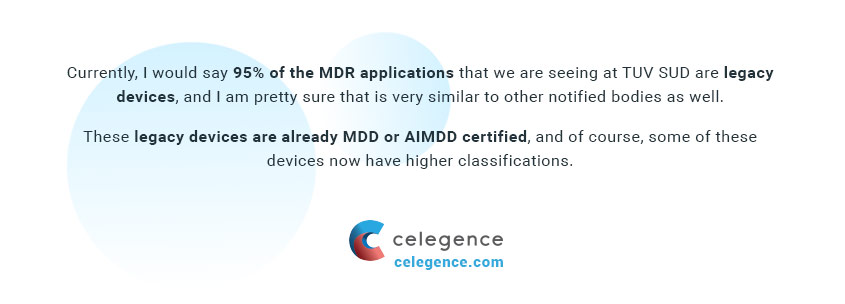
MDCG 2020 – 6 Clinical Data for Legacy Devices
Currently, I would say 95% of the MDR applications that we are seeing at TUV SUD are legacy devices, and I am pretty sure that is very similar to other notified bodies as well. These legacy devices are already MDD or AIMDD certified, and of course, some of these devices now have higher classifications. The problem is that some of those devices probably did not come under such high scrutiny in the past by their notified body, so the manufacturer might have identified some data gaps. Which we have seen specially for devices going from 2A to 2B.
And of course, it is not the intention of the MDR to make a lot of medical devices obsolete that are currently approved and widely used, just because they might have some gaps in clinical data. So, this is why we have the MDCG 2020 – 6 guidance document, which is meant to help manufacturers keep legacy devices on the market as long as they fulfil certain requirements.
MDCG 2020-6 Well Established Technology (WET)
We now have a definition in the MDCG document on well-established technology. They must have a relatively simple, or common and stable design. The device group must have well-known safety and risk benefits, with no major safety issues in the past. Not every device that is a legacy device is automatically a well established technology. For example, on this slide – spinal disc replacement devices for spinal disc diseases – which have a fairly long history. I believe they started in the 80s, but they have had a lot of problems with respect to different designs. There is not one common design and there were many recalls, so those devices have fulfilled one or two of those criteria, but are still not considered as a well-established technology. For those devices which are considered a well established technology, and for which there is not sufficient data on the market, then MDCG 2020 – 6 basically allows for those types of devices to use clinical data on a lower evidence level. For example – the state of the art data required to keep devices on the market under the MDR, but then of course with the equivalence demonstration, the manufacturer needs to close this gap with the clinical data in the post market clinical follow-up.
Combination Products
One important thing for drug device combinations products, is whether the integral part is a medicinal product, or if it is a medical device. In the end, the manufacturer has to decide on its own.
The 2001/83/EC regulation for medicinal products is much more stringent, and a much more complex medical device regulation. If you are going to apply as a medical device combination product then the notified body is going to check your application process for the classification of that device. Some things have changed with the MDR, the initial applications of all legacy devices have to undergo a re-consultation depending on the previous consultation report from the commanding authority. It might be only a short consultation, but that will be decided by the authorities.
With the MDD, there were certain devices that were not required to have a consultation if the medicinal product is not a liable actor upon the body, but this is now removed with the MDR. So, for the MDR, all medical devices which in some form incorporate the medicinal product, must undergo the consultation. So, this is one of the largest differences.
For the clinical data, there is no real difference between a medical device that incorporates a medicinal substance or not, because the manufacturer needs to have the clinical data needed to demonstrate the safety and performance of the device. When it comes to equivalence, as an example, for an antibacterial coated and an uncoated version of your product, it would not be possible to claim equivalence between the coated and uncoated versions.
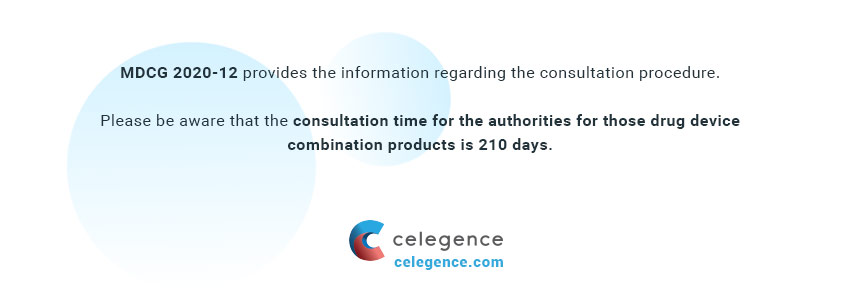
Documentation Package for Consultation
MDCG 2020-12 provides the information regarding the consultation procedure. Please be aware that the consultation time for the authorities for those drug device combination products is 210 days.
Notified bodies are not allowed to continue with the certification process before the consultation reports and opinions are provided by the authority. So, you have to factor that into your process if you have a device that contains a medicinal product as an integral part. Be aware that the certification process will be much longer just because of this long period of time that is reserved for the consultation process with your authority.
Software as a Medical Device
I have not seen a lot of active software as a medical device related products, but there are two definitions you have to differentiate. Either as a software, only to be used as a medical device, or as a software which has an intended purpose of its own. For example, a medical device software smart watch app, which is intended to send alarm notifications to the user and/or health practitioner when it recognizes irregular heartbeats for the purpose of detecting cardiac arrhythmia. Then of course, the software will have its own intended purpose. According to MDCG 2020-1, it depends if it is a standalone software or not.
If it is a software that is related to the example here that we just talked about, with the medical device in this case being a smartwatch, then of course the clinical evaluation needs to consider the software + device itself. If it is a standalone software, then the manufacturer needs to have the clinical data for the software alone. In case the software is driving or influencing the use of a medical device with no independent intended purpose or independent claimed clinical benefit, then no clinical data or clinical evaluation report for the software itself is required
Conclusions
This was a very quick run through of the requirements under the MDR for clinical data. As I said, there is no real difference between those devices, and the basic requirements of article 61 are valid for all the devices. Something very important though, is that the equivalence demonstration that we have seen in the past, will no longer be valid for most devices. There is a way for legacy devices to stay on the market, and that is with MDCG 2020-6, with any kind of data gaps identified by the manufacturer being addressed in the PMCF. With that, I thank you for your time today!
